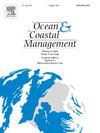分区对中国重点多用途海洋保护区鱼类种群的影响
IF 5.4
2区 环境科学与生态学
Q1 OCEANOGRAPHY
引用次数: 0
摘要
多用途海洋保护区(MMPAs)的特点是具有不同保护水平的区域,越来越被认为是必不可少的渔业管理工具。然而,对其分区影响的全面了解仍然有限。本研究调查了盛泗海洋公园的分区对鱼类种群的影响。盛泗海洋公园是长江三角洲著名的海洋保护区,以其重要的资源利用和人为干预而闻名。利用广义加性模型(GAMs),我们评估了分区对鱼类群落特征的影响,并假设高保护等级的区域及其邻近区域在各种鱼类群落指标上都表现出更高的值。研究结果在一定程度上支持了这一假设:物种总丰富度和低商业重要性(LCI)物种的生物量往往在最高保护等级的区域最高。在二级保护区内,只有具有高商业重要性(HCI)物种的生物量高于三级保护区内。值得注意的是,与最高保护区相邻的区域,HCI鱼类的生物量增加,表明潜在的溢出效应。不同生态指标对分区的相对影响存在差异:中等商业重要性(MCI)物种的平均大小对分区的相对影响最大(18.86%),其次是总物种丰富度(15.49%),所有物种的平均大小(14.81%)。总丰度的影响最小,为0.03%,LCI丰度和生物量的影响分别为0.03%和0.18%。虽然分区对HCI和LCI物种都有显著影响,但对HCI物种的影响更为明显,这进一步支持了我们关于基于商业重要性的差异影响的假设。多变量分析表明,分带解释了7%的物种组合变化。两两比较显示了三级保护区之间的显著差异,其中光舌蝇(Cynoglossus lightti)成为最具影响力的物种,占总保护区差异的9%。本研究对中国海洋保护区分区的生态效应提供了新的见解,并强调了海洋保护区作为整合海洋保护和渔业管理的有效空间管理工具的潜力。本文章由计算机程序翻译,如有差异,请以英文原文为准。

Zoning effects on fish populations in a key Chinese multi-use marine protected area
Multi-use marine protected areas (MMPAs), characterized by zones with varying levels of protection, are increasingly recognized as essential fishery management tools. However, comprehensive understanding of their zoning impacts remains limited. This study investigates the effects of zoning on fish populations within Shengsi Marine Park, a prominent MMPA in the Yangtze River Delta known for its significant resource utilization and human intervention. Using Generalized Additive Models (GAMs), we evaluated how zoning influences fish community characteristics, hypothesizing that higher protection level zones and their adjacent areas would show increased values across various fish community indicators. Our results partially supported this hypothesis: total species richness and the biomass of low commercial importance (LCI) species tended to be highest in the highest protection level zone. In the second protection level zones, only the biomass of high commercial importance (HCI) species was tended to be higher than that in the third protection level zones. Notably, zones adjacent to the highest protection level zone showed enhanced biomass of HCI fishes, indicating potential spillover effects. The relative influence of zoning varied across ecological indicators: the mean size of moderate commercial importance (MCI) species demonstrated the highest relative influence at 18.86%, followed by total species richness at 15.49%, and the mean size of all species at 14.81%. In contrast, total abundance had the lowest influence at 0.03%, with LCI abundance and biomass at 0.03% and 0.18%, respectively. While zoning significantly influenced both HCI and LCI species, the impacts were more pronounced for HCI species, further supporting our hypothesis regarding differential impacts based on commercial importance. Multivariate analyses indicated that zoning explained 7% of species assemblage variation. Pairwise comparisons highlighted significant differences between third protection level zones, with Cynoglossus lighti emerging as the most influential species, contributing 9% to total zone dissimilarity. This study provides novel insights into the ecological effects of zoning in Chinese MMPAs and underscores the potential of MMPAs as effective spatial management tools that integrate marine conservation and fisheries management.
求助全文
通过发布文献求助,成功后即可免费获取论文全文。
去求助
来源期刊

Ocean & Coastal Management
环境科学-海洋学
CiteScore
8.50
自引率
15.20%
发文量
321
审稿时长
60 days
期刊介绍:
Ocean & Coastal Management is the leading international journal dedicated to the study of all aspects of ocean and coastal management from the global to local levels.
We publish rigorously peer-reviewed manuscripts from all disciplines, and inter-/trans-disciplinary and co-designed research, but all submissions must make clear the relevance to management and/or governance issues relevant to the sustainable development and conservation of oceans and coasts.
Comparative studies (from sub-national to trans-national cases, and other management / policy arenas) are encouraged, as are studies that critically assess current management practices and governance approaches. Submissions involving robust analysis, development of theory, and improvement of management practice are especially welcome.
 求助内容:
求助内容: 应助结果提醒方式:
应助结果提醒方式:


